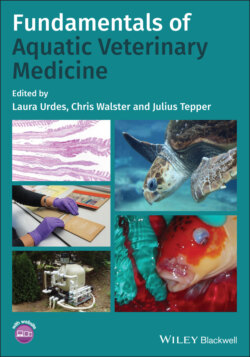Читать книгу Fundamentals of Aquatic Veterinary Medicine - Группа авторов - Страница 54
1.5.3 Environmental Toxins and Pollutants 1.5.3.1 Heavy Metals
ОглавлениеHeavy metals occur naturally in the environment due to geologic weathering but can also occur from human use. It is important to survey the immediate environment as well as the areas upstream to the water source used in an aquasystem. Atmospheric pollution from coal combustion is a major cause of many heavy metals being found in source water. Residential and agricultural use of pesticides and fertilizer may contribute to several types of heavy metals in groundwater, well water, lakes, ponds and estuaries. Other types of industrial waste to consider are leather tanneries, textile industry, battery storage or production, plastic production, metal finishing, mining, and pigment production.
There are essential and non‐essential heavy metals. Essential metals include copper, zinc, chromium, nickel, cobalt, molybdenum and iron. Nonessential metals include cadmium, mercury, tin and lead (Sfakianiakis et al., 2015).
Essential metals can cause disease if they are deficient and if the levels are too concentrated. The most bioavailable form of these metals is the dissolved ionic form. These metals help during larval development of the neurologic and gastrointestinal systems (Sfakianakis et al., 2015; Authman et al., 2015).
Essential and nonessential heavy metals can cause damage at high concentrations. Knowing that there is potential for heavy metal in the water source is an important part of diagnosing decreased reproductive health, slow growth, and acute mortalities. The periods during which fish are most susceptible to heavy metal toxicity are the embryonic and larval stages. They can cause lordosis, increased mortality, hatching delays and other anomalies. According to Sfankianakis et al. (2015), morphological deformities are commonly used as a biomarker to study the effects of contamination.
Fish are susceptible to heavy metals through their gills, gastrointestinal tract and through skin absorption. These metals will accumulate in the liver, kidney, and gills. Arsenic has also been found to accumulate in the retina and cadmium has been found in the heart muscle (Authman, 2015).
Although there are differences in the mechanism of action, most heavy metals cause damage to the liver, gills, reproductive, immune, and neurologic systems. They cause damage to the gills through hyperplasia and necrosis. Aluminum causes lamellar fusion which leads to necrosis. Iron accumulates in the gills as a precipitate causing vascular occlusion. At chronic doses, many heavy metals negatively affect leukocytes, erythrocytes, and antibodies. They can also affect the endocrine system, decreasing reproductive health. Iron can precipitate on eggs causing a reduction of oxygen reaching the larvae. Other heavy metals decrease growth through increased biological stress, disruption of osmotic balance, and developmental changes. Many heavy metals cause neurologic damage, including mercury, which causes behavior changes, cognitive changes, ataxia, and convulsions (Kennedy, 2002).
Studies on cadmium show that it is primarily absorbed via the gastrointestinal system and the gills. It interrupts the absorption of calcium, which can cause problems with reproduction, growth, and development. It can also cause acute death from hypocalcemia. Cadmium levels as low as 0.001 ppm affect the hatching and larval survival of many species of fish.
Studies have been performed showing that excessive copper can affect the gills, gastrointestinal system, and the sensory system. These studies showed that zebra fish larvae had difficulty orienting in the water column, reduced hatching and impairment of growth (Authman, 2015).
